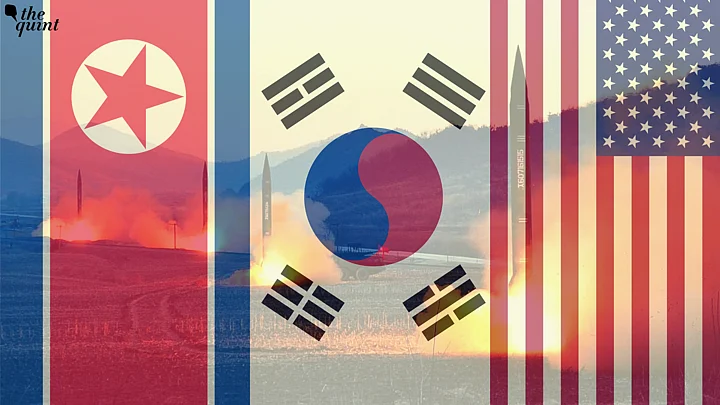North Korea conducted a ballistic missile test further than ever before on Tuesday, 4 October, prompting worry in Japan as citizens were forced to take coverafter the missile soared over them.
This was the first North Korean missile to follow such trajectory since 2017 and its 4,600 km range was the longest travelled by a North Korean test missile, which are “lofted” high into space to avoid neighbouring nations, Reuters reported.
To compare, if the missile had taken a different trajectory, it would have hit Guan, a US micro-island.
In a response to North Korea’s test, the United States and South Korea sent warplanes to practise bombing targets in the Yellow Sea, again prompting Japan to warn its citizens to take cover and suspend a few trains as the missile passed over North Japan and fell into the Pacific Ocean, The Guardian said.
'Please Evacuate'
Residents in northern Japan’s Hokkaido island and Aomori city, among other places, woke up to the noise of sirens and text alerts, according to BBC, which read:
"North Korea appears to have launched a missile. Please evacuate into buildings or underground."
As the missile flew overhead, they were warned to look out for falling debris.
Last week, the US, Japan and South Korea conducted naval drills together for the first time since 2017.
Following the combined exercises of 2017, Kim Jong Un, who has previously stated that he considered such drills as signs of his enemies preparing for war, fired two missiles over Japan in response. A week later, it conducted a nuclear test.
Military Displays
The test by the Democratic People's Republic of Korea (DPRK), as North Korea is officially known, with five missile launches in the last ten days, was the latest muscle flex in the region after a US aircraft carrier made a port call in South Korea on 23 September for the first time since 2018.
During this time, the US, Japan, and South Korea also conducted joint drills, and US Vice President Kamala Harris stood at the De-Militarised Zone, the fortified border between North and South Korea, and accused the North of undermining security.
Meanwhile, North Korea accused the US and its allies of threatening it with defence buildups, shows of strength and military exercises.
With tensions high, the US military has stepped up displays of force in the region.
The US and South Korea responded to the North Korean missile test with one of their own after a South Korean F-15K jet dropped a pair of guided precision bombs on a target off the country’s west coast.
The South Korean military has called the move a demonstration of its precision strike capabilities against the source of North Korean provocation.
Reactions
While Japanese Prime Minister Fumio Kishida called the launch “violent behaviour,” Defence Minister Yasukazu Hamada said that it would not rule out any options including counterattack capabilities, even though Japan took no steps to shoot down the North Korean missiles, Reuters reported.
South Korea stated that it would boost military strength and increase corporation amongst allies.
Meanwhile, the US strongly condemned the “dangerous and reckless” launch.
National Security Council spokesperson Adrienne Watson said in a statement, “This action is destabilising and shows the DPRK's blatant disregard for United Nations Security Council resolutions and international safety norms.”
Secretary of State Antony Blinken also held phone calls with his Japanese and South Korean counterparts, where they “strongly condemned” North Korea’s missile test, according to BBC.
The launch is a violation of resolutions by the United Nations (UN) Security Council which have imposed sanctions over DPRK’s nuclear and missile programs.
The UN prohibits North Korea from testing ballistic and nuclear weapons. Flying missiles towards or over other nations without any warning or consolation is also a contravention of international norms.
(With inputs from BBC, The Guardian, and Reuters)
